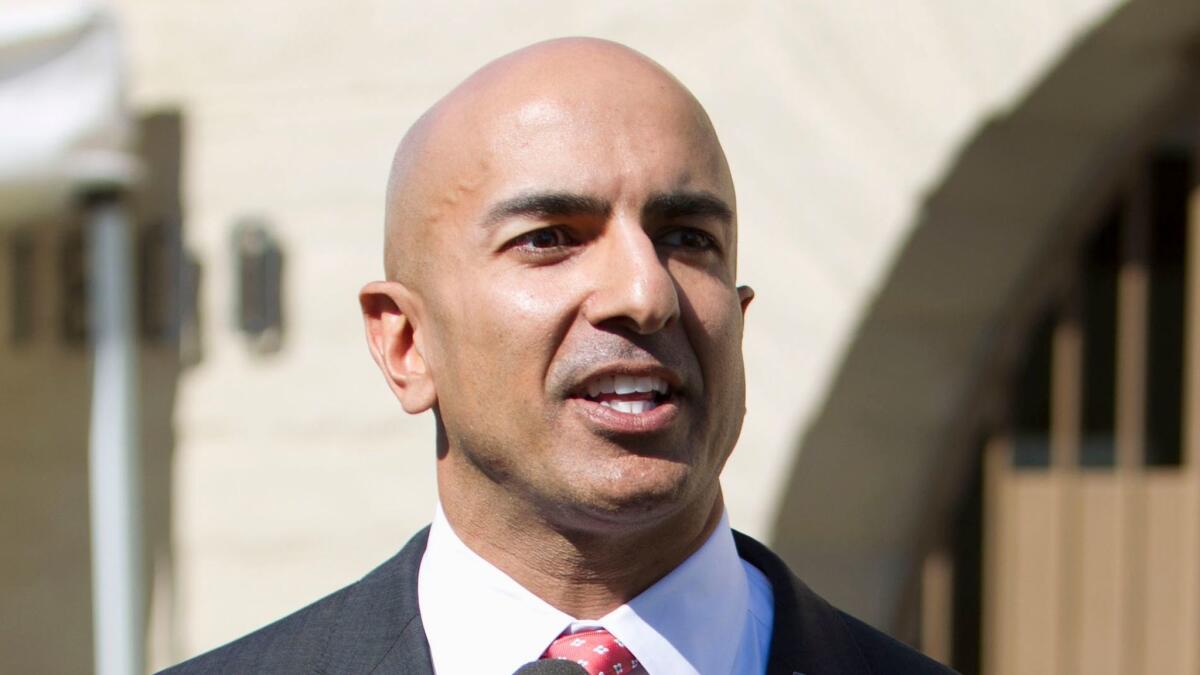Why did Fed’s Neel Kashkari oppose a rate hike? The economy’s not ready for it, he says

Reporting from Washington — Neel Kashkari, the only Federal Reserve policymaker to vote against an interest rate hike this week, said he balked because the economy’s not ready for it.
The president of the Fed’s Minneapolis regional bank, explained in an essay Friday that inflation still hasn’t hit the central bank’s 2% annual target, the job market has room to improve and financial market assumptions about stimulus policies from the Trump administration are premature.
“Financial markets are good at some things, but, in my view, notoriously bad at forecasting political outcomes,” said Kashkari, who knows politics after running unsuccessfully for California governor in 2014 and administering the federal government’s bank bailout fund during the 2008 financial crisis.
“They didn’t forecast ‘Brexit.’ They didn’t forecast the results of the U.S. presidential election,” he said. “I don’t have much confidence in their ability to forecast fiscal policy given how little we know today.”
Kashkari’s also not so confident in the Fed’s own forecasts.
“We keep predicting that inflation is around the corner,” he said, noting that the Fed’s medium-term inflation forecasts over the past five years all have been too high.
He has the same concerns about suggestions the economy is at full employment as the jobless rate declined to 4.7% last month.
“The bottom line is the job market has improved substantially, and we are approaching maximum employment,” he said. “But we aren’t sure if we have yet reached it. We may not have.”
The other nine voting members of the Federal Open Market Committee opted to nudge up the central bank’s key short-term interest rate Wednesday.
They cited recent solid job growth and rising inflation for increasing the rate 0.25 percentage points to a target between 0.75% and 1%. It was the second rate increase in three months, and Fed policymakers signaled two more raises are coming this year.
“The simple message is the economy is doing well,” Fed Chairwoman Janet L. Yellen told reporters after the committee’s two-day meeting.
Kashkari, who this year rotated into one of five voting slots reserved for the 12 regional Fed presidents, said the economy is not doing well enough. Conditions hadn’t markedly changed from February, when he and the other nine voting members held the rate steady, he said.
“We are still coming up short on our inflation target, and the job market continues to strengthen, suggesting that slack remains,” Kashkari said.
He said he’d prefer that the Fed tighten monetary policy first by developing a plan to sell some of the $4.5 trillion in assets acquired since the crisis during earlier rounds of stimulus known as quantitative easing.
Yellen reiterated Wednesday that she wants to wait to reduce the Fed’s assets until after more interest rate hikes.
It’s just another way Kashkari is at odds with Yellen. He has staked out an outspoken role at the Fed since taking the Minneapolis job at the start of 2016.
The former Goldman Sachs Group Inc. executive rose to prominence during the 2008 financial crisis when then-Treasury Secretary Henry M. Paulson tapped him to run the $700-billion bank bailout initiative known as the Troubled Asset Relief Program. He left the government in 2009 to work for Pimco.
As head of the Minneapolis Fed, Kashkari launched an initiative to craft a solution to the problem of too-big-to-fail banks.
The plan, released in November, proposed to prevent future bailouts by forcing the biggest U.S. banks to hold much more capital. The requirements, in effect, would force many of those institutions to break up.
“We will have fewer mega banks, and there will be far less concentration in the banking system,” Kashkari said. “If there are any … [too-big-to-fail] banks left, they will be so well-capitalized that their risk of failure will truly have been minimized.”
The plan would require congressional legislation.
Trump says businesses can’t borrow because of Dodd-Frank. The numbers tell another story »
Obama saw low-wage workers as struggling moms. Trump may see them as suburban teens »
Follow @JimPuzzanghera on Twitter
More to Read
Inside the business of entertainment
The Wide Shot brings you news, analysis and insights on everything from streaming wars to production — and what it all means for the future.
You may occasionally receive promotional content from the Los Angeles Times.










